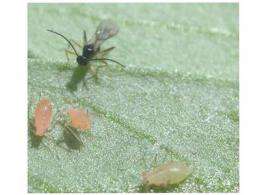Aphids saved from gruesome death by virus-infected bacteria

The term "beneficial virus" sounds like an oxymoron. But for pea aphids under attack by parasitic wasps, carrying infected bacteria is the difference between life and a slow death, according to new research.
The wasps lay eggs inside the aphids, and the wasp larvae eat the living aphids from the inside out.
"A parasitoid death would be a very gruesome death," said first author Kerry M. Oliver. "It's like the movie 'Alien' where this thing grows inside of you and then ruptures out of you and kills you."
In laboratory experiments, about eighty percent of aphids carrying uninfected Hamiltonella defensa bacteria died as a result of wasp attacks.
However, most of the aphids whose H. defensa bacteria had a particular virus did survive wasp attacks.
The research is the first demonstration that a virus that infects bacteria can help rather than harm the bacteria's animal host, Oliver said.
He and his colleagues conducted the research at The University of Arizona in Tucson.
The researchers also tested strains of aphids whose bacteria had once been infected but were no longer.
"In every instance where the virus was lost, protection was lost almost completely," said Oliver, now an assistant professor at the University of Georgia in Athens.
The virus, known as APSE, carries genes that code for toxins the researchers think are involved in the anti-wasp defense.
By contrast, being infected by viruses toting toxin codes often makes disease-causing bacteria such as E. coli more, not less, harmful to their human hosts.
Biologists call the part of the APSE viral DNA that codes for toxins a "mobile genetic element." The virus can and does move that mobile genetic element between individual bacteria and between different species of bacteria, Moran said.
The mobile genetic element can become incorporated into the recipient's DNA, giving the recipient the ability to make the toxin.
Species-to-species transmission of DNA via mobile genetic element is quite different from the well-known means by which parents pass on their genetic material to their offspring. In animals, pieces of DNA typically cannot jump from one adult organism's genetic material to another adult organism's genetic material.
"The coolest thing to me is that you can have selection and adaptation for (wasp) resistance that occurs in one species and then, whoosh, it could suddenly appear in another species," Moran said.
Pea aphids can be agricultural pests and Aphidius ervi, the wasp the researchers tested, is used to control aphid populations.
The team's research may also reveal why biological control of aphids with wasps works sometimes but not others, she said.
"Our work suggests it depends which virus the bacteria have."
Oliver and his UA colleagues Patrick H. Degnan, Martha S. Hunter and Nancy A. Moran, will publish their paper, "Bacteriophages Encode Factors Required for Protection in a Symbiotic Mutualism," in the August 21 issue of the journal Science.
Moran, a UA Regents' Professor of ecology and evolutionary biology, has been investigating the role internal symbiotic bacteria play in the lives of the pea aphid Acyrthosiphon pisum for more than 15 years.
Aphids and other insects that feed on sap often house several species of such bacteria. Some, known as primary symbionts, provide aphids with essential nutrients that are not available in the nutrient-poor plant sap.
Aphids cannot survive without their primary symbionts, and those symbionts cannot survive outside of aphids.
The aphid-primary symbiont relationship is so close that the bacteria live inside specialized cells within the aphid.
In addition, aphids often carry other bacteria known as secondary symbionts. Those are symbionts that are needed for survival and reproduction only under certain conditions, such as the presence of particular enemies.
Oliver, working with Hunter and Moran, discovered that aphids carrying the secondary symbiont Hamiltonella defensa were wasp-resistant, but aphids without H. defensa were susceptible.
But when aphids were kept in the laboratory for generations without being exposed to the wasps, some strains lost their ability to resist wasp attacks, the researchers found.
It turned out that the susceptible aphids still carried the H. defensa bacteria, but the bacteria had lost the APSE virus.
To rule out genetic differences between aphids or bacteria as the source of wasp susceptibility, the researchers needed to do another experiment.
The team compared aphids that had H. defensa with APSE virus to the same strain of aphids carrying the same strain of H. defensa but without the virus.
When exposed to the wasps, about 90 percent of aphids with infected bacteria survived wasp attacks. Aphids without infected bacteria were pretty much doomed.
"It really shows how complicated life is," Oliver said. "It's really a microbial world."
The National Science Foundation, the U.S. Department of Agriculture and the National Institutes of Health funded the research.
Source: University of Arizona (news : web)
















